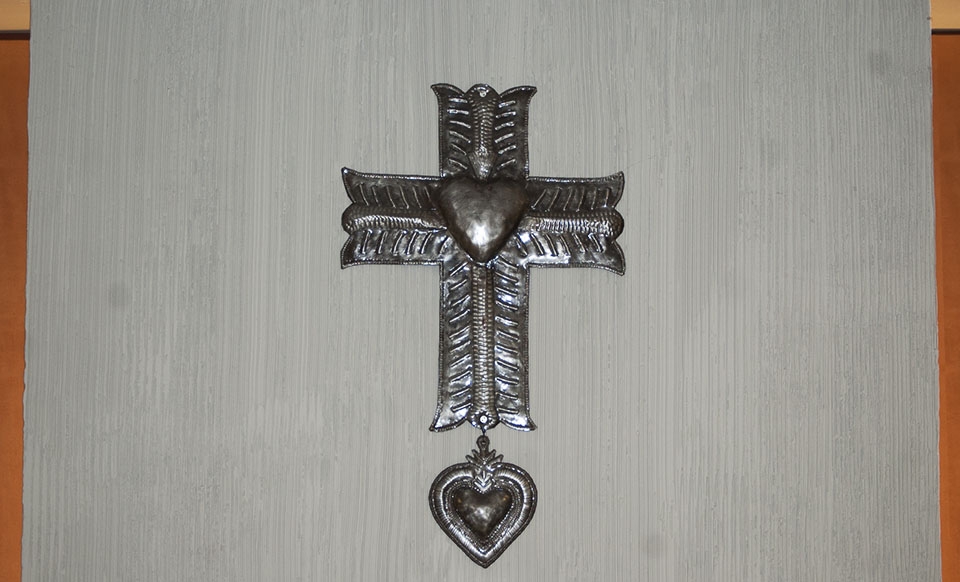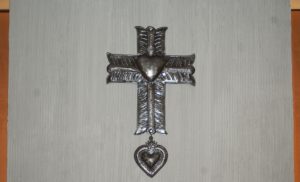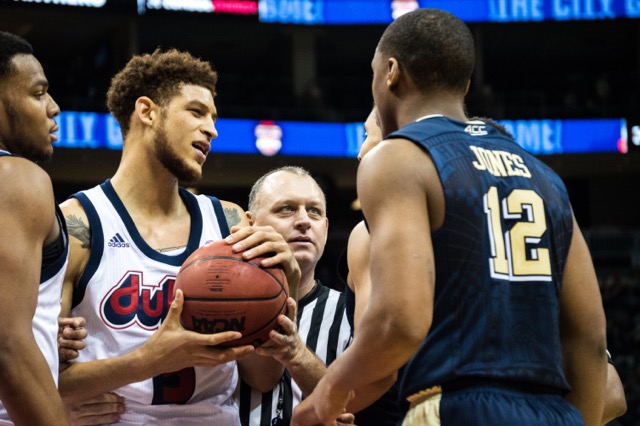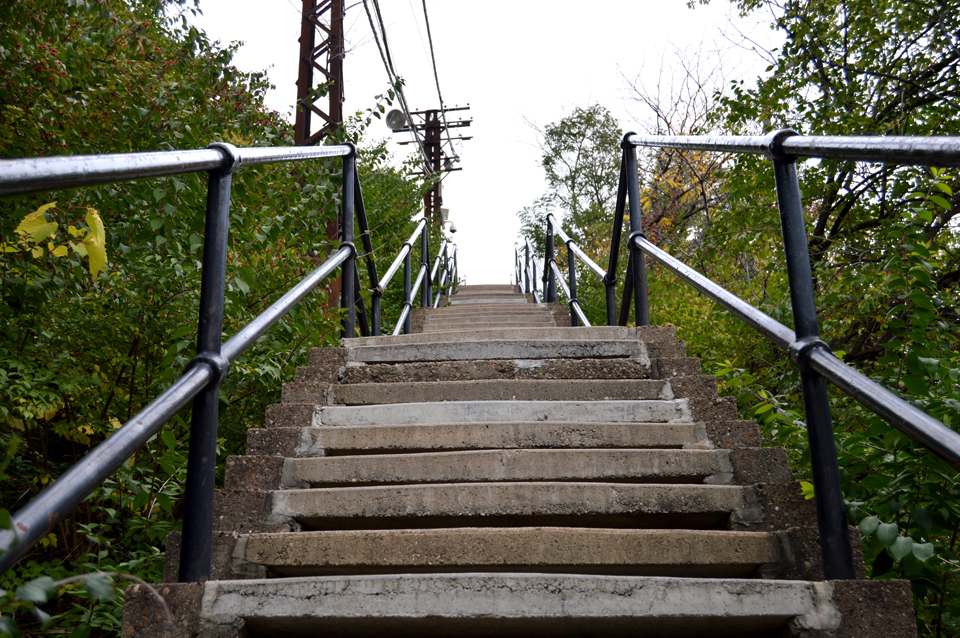

This Haitian sacred heart cross hangs in the second floor of the Union. Many crucifixes are stylized to reflect the different cultures that they are produced in.
Krystina Primack | Staff Writer
04/19/2018
In 2002, St. John Paul II said, “[The crucifix] is the sign of God, who has compassion on us, who accepts human weakness, who opens to us all, to one another and therefore creates the relation of fraternity.”
This concept of connectedness comes to mind when reflecting upon the campus culture here, where diversity and learning are greatly encouraged. In many ways, these ideals are illustrated by the artistic renderings of crucifixes and crosses on our campus. Several of them step away from the standard forms of Christ and lean toward a variety of inspirations and cultural backgrounds.
To conclude this series on crucifixes, we will explore the importance of a few other notable religious icons on campus, what they mean to others in our community and, finally, how the community as a whole is bound together by their central ideas.
When asked about religious iconography on campus, Duquesne Hillel Jewish Students Organization President David DeFelice, a junior political science and international relations major, said, “[The iconography] certainly is thought-provoking and open to interpretation. A good example of this is the flames of the Holy Spirit [statue] in front of the Union. It’s a representation I am unfamiliar with, but fire is certainly symbolic in Judaism as well as Christianity, so one can individualize such iconography.”
Beyond The Spirit of Duquesne, we are accustomed to the more traditional crucifixes displayed on campus, in most offices and classrooms. As art history professor Christine Lorenz said, “The crucifixes we see in [the] classrooms blend into the background … but they serve as ever-present reminders of the identity of the institution we’ve chosen to participate in, at whatever level that may be.”
Christy Nale, a sophomore corporate communications major, said, “[The crucifix] is present in [most rooms] on campus, and it gives a more loving feeling, in my opinion, to the university.”
Many of the crucifixes tend to incorporate a standard design — a simple wooden cross with a figure of Christ attached to it. But other locations present crosses that are more stylized, much like our Scary Jesus.
The Student Union has a notable set of crosses that represent faith and unity, with designs that go beyond the simplistic: The Southwest Cursillo cross that celebrates variety, the Haitian sacred heart cross which was crafted from an oil drum and the African cross whose figure of Christ is made of ebony. Each of these can be found in the Fishbowl lounge area, the 2nd floor lobby in front of Health Services and the PNC Atrium respectively.
The otherwise unorthodox material of the sacred heart cross is significant, as it is a Haitian tradition to convert oil drums into wall sculptures. In this case, the piece represents Duquesne’s tradition of inclusiveness. Likewise, the Southwest Cursillo cross bears importance in its design by reminding us of the equimenical approach to spirituality and religion.
The Risen Christ sculpture is another noteworthy — and rather distinctive — cross on our campus that reflects the Spiritan traditions.
This sculpture was crafted by French artist Sebastian Touret. Dedicated in the fall of 2013, the piece stands behind the altar in the Chapel of the Holy Spirit and was initially commissioned by former Duquesne President Charles Dougherty in 2012. Interestingly, the cross is actually a replica whose original is in Paris, France, in front of Spiritan priest Daniel Brottier’s tomb.
Touret works primarily with wood and metal, and his sculptures are usually meant to resemble human silhouettes. This unique style is reflected in his Risen Christ statue.
Touret also strives for his sculptures to be “presences,” or to create a sense of life in the space they occupy. In the case of Risen Christ, the presence is meant to be positively received by the viewer.
Lorenz said “[The statue] has a modern simplicity that is so streamlined that it’s almost as elemental as a cross. If the cross takes one direction of departure from the crucifix, this sculpture looks like it takes a simple, very joyful turn to the flip side.”
Much like Jose Pirkner’s Crucifix, Touret’s statue is also highly representative of the artist’s distinct style.
In a grander sense, this statue and other religious iconography on campus and their underlying meanings can serve as a way to remind us of why this community exists in the first place. We attend an institution of higher education, and as such, it is important to remember that learning extends beyond the classroom.
As Pope Francis said in a 2013 in the Italian newspaper La Repubblica, “We need to get to know each other, listen to each other and improve our knowledge of the world around us … Expand the circle of ideas.”
We can apply this advice to the importance of bringing the community of our campus together.
“When it comes to art in public places, the university has found success in commissioning murals that are engaging and full of life, and at their best, they inspire a sense of unity in what we share,” Lorenz said.
“Duquesne’s campus has a wide range of students. Many cultures are celebrated throughout the year on campus, as well as many religions. Although Duquesne is primarily a Catholic campus, it does a good job of including people from all backgrounds,” Nale said.
In fact, there are many organizations here beyond our clubs and organizations whose goal is to encourage community and success.
Likewise, Community Engagement through Spiritan Campus Ministry includes: Cross Cultural Mission Experiences, Evergreen, St. Vincent De Paul Society and Fair Trade at Duquesne. Each of these organizations work in different ways to serve the community and its members, bringing students and faculty together for worthy causes.
DeFelice said, “It depends what metric one uses to measure diversity, but I would definitely say that Duquesne is diverse. Whether it be with ability, intelligence or interests, we are an eclectic school … I see our campus promoting efforts to grow in diversity when it comes to race, ethnicity and religion. I believe we are strongly positioned to grow in our diverseness and continue to make sure all students feel comfortable on our campus.”
Crucifixes as religious icons carry a deep and often personal meaning for Catholics, as well as for many other Christian denominations. Understandably,
crucifixes are prominently displayed at this university whose establishment was based upon the principles of the church and the Spiritans.
For many members of our student body that practice other faiths, the presence of the crucifixes in classrooms and other locations on campus have come to reflect our university’s mission to foster students from all walks of life, reminding us of this school’s history and ambition not only to educate, but to promote personal growth as well.




